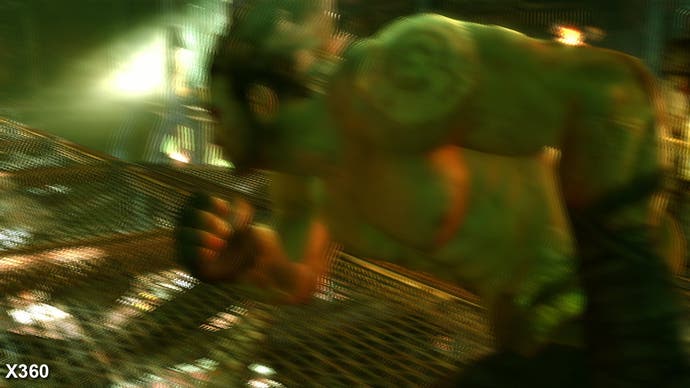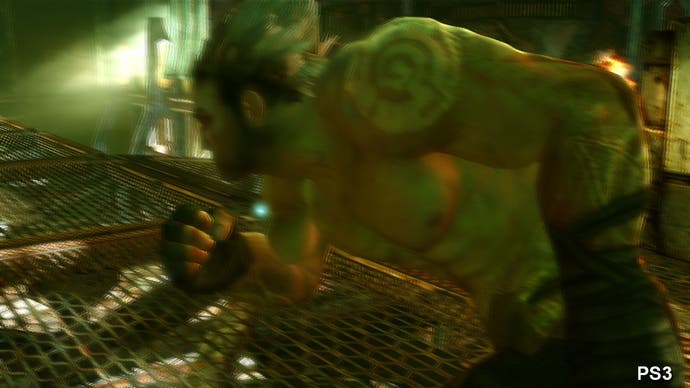Enslaved PS3/360 demo showdown
First public release code put to the test.
Namco Bandai's Enslaved is drawing plenty of attention thanks to the involvement of some heavyweight creative talent: Heavenly Sword developer Ninja Theory is on coding duties, Lord of the Rings star Andy Serkis plays the male lead, while The Beach scribe Alex Garland provides the story. The fact that the game looks utterly gorgeous doesn't exactly harm its prospects either.
In moving from working exclusively with the PS3 onto a cross-format project, Ninja Theory has also migrated across to a more multi-platform friendly development environment: Unreal Engine 3.
There is something of a pattern to console releases using the UE3 tech. Typically we see a performance advantage on Xbox 360, the extent of which is often minimal but varies from title to title. Over and above that, the 360 games tend to feature 2x multi-sampling anti-aliasing, the impact of which is diminished somewhat by successive effects in the rendering process effectively erasing much of the edge-smoothing, while other effects such as screen space ambient occlusion (SSAO) tend to be reserved for 360 only. However, it's fair to say that as UE3 has evolved the gap between the two platforms has diminished somewhat.
Based on the demo code, Enslaved appears to buck the established trend in some respects, but emphasises it in others. Raw performance is the main concern here. UE3 operates on what is fast becoming the industry standard - aim for 30FPS, then kick in with the screen-tear if you can't keep your rendering in budget. In this respect, in most UE3 titles we see 360 less prone to tearing though often the overall effect isn't really worth comment.
This definitely isn't the case with Enslaved, which appears to be relatively stable on 360, but has real issues with screen-tear on PS3. Here's a truncated edit of the action from the demo, showing identical scenes and gameplay taken from the same in-game areas.
On the engine-driven cut-scenes, Ninja Theory appears to employ v-sync on 360, with just the odd frame coming in over budget, resulting in an occasional tear at the top of the screen. This explains quite nicely why cut-scene rendering fluctuates between 30FPS and 20FPS. The engine is waiting for the display's vertical refresh before outputting the next frame – sometimes the frame is ready to render after 33ms (30FPS), sometimes it isn't. PS3 on the other hand isn't v-synced at all, so there is an almost constant tearing. Sometimes this gives a small frame-rate boost over 360, other times it doesn't.
Into gameplay and it's clear that the Enslaved demo is a game of two halves. The exterior scenes meet budget fairly well, and both platforms operate at 30FPS with only occasional dips. In the more detail-rich interiors, however, PS3 has real problems maintaining performance without some serious screen-tear issues.
The last scene in the performance analysis is interesting in that it's actually a pre-rendered video. There are several of these in the demo and the quality is generally excellent on both platforms. They're either extremely well encoded or else lavish amounts of bandwidth have been gifted to them to keep the quality so high (which begs the question of whether the 360 version can maintain this quality with only 6.8GB of space available on disc for the whole game). However, bizarrely, even here we see that the PS3 version can sometimes tear - which must surely be a bug.
Performance aside, there are not so many differentiating factors. The borderline-useless MSAA in the 360 UE3 appears to be turned off here meaning both games are rendering at 720p with no anti-aliasing. Bloom is used liberally which helps mask some of the aliasing, and while this appears to have been dialled up a notch on the Microsoft platform, the games' overall look is mostly identical (though a window texture appears to have dropped off the pod in the opening cut-scene on 360).




The only appreciable visible difference is in the motion blur. In the past we've seen this effect completely absent from PS3 UE3 titles, but it is implemented in Enslaved on both platforms. However, the Xbox 360 effect is processed with more samples.
So in terms of overall image quality, it certainly look as though Enslaved: Odyssey to the West won't disappoint on either platform. But equally, the performance differential on those engine-stressing scenes is a bit worrying, and it's something we'd hope is far less of an issue in the final release code. Expect to see more in-depth coverage closer to the game's 8th October release date.

